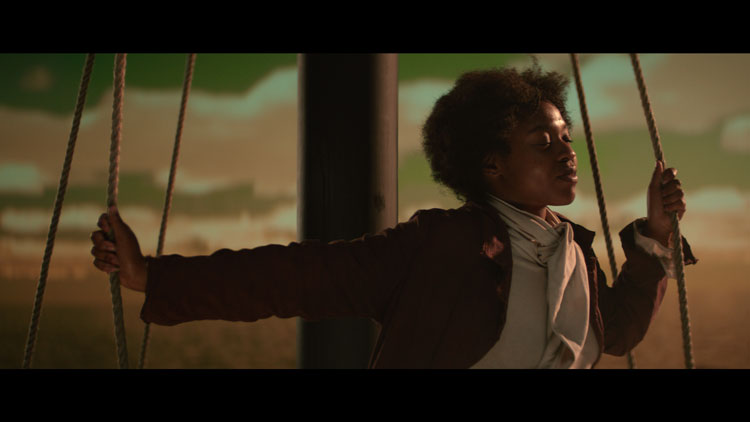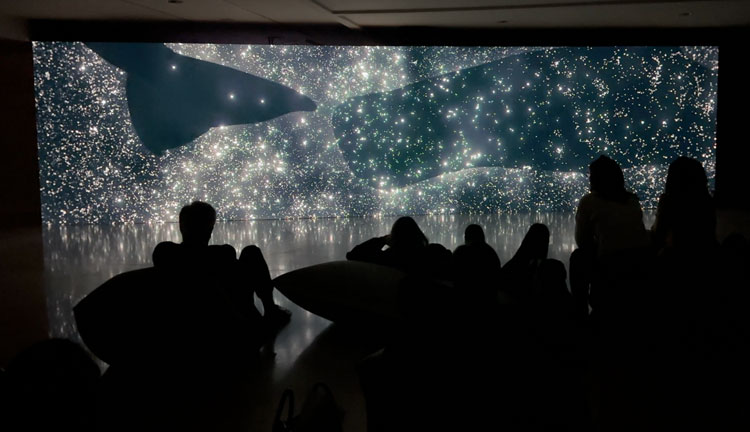In her interdisciplinary practice, the American artist and film-maker Wu Tsang focuses on marginalised and unheard histories, often working collaboratively across performance, poetry, music and film to present multiple narratives. Herman Melville’s classic American novel Moby-Dick about a captain’s obsessive quest for the albino sperm whale that took off his leg could at first seem an unlikely choice for Tsang as the basis for her multi-part film project, but the artist’s adaptation underscores stark resonances with our own fraught times.
The novel Moby-Dick was completed in 1851, a decade before the start of America’s racially charged civil war, and Melville’s reflections on the theme of “whiteness” – to which he dedicated a chapter – are complex and contradictory, to say the least. Tsang has approached Melville’s novel through a postcolonial lens, bringing out alternative, richly layered readings in her 2022 film trilogy, which comprises the silent feature-length film MOBY DICK; or, The Whale, a collaboratively produced installation film, Extracts, about its making, and an immersive video installation, Of Whales. “There are a lot of things in that book that I find to be very problematic. It’s very racist and it glorifies colonialism and hunting of whales, but it’s also a very beautiful book about the relationships of the people on the ship,” says Tang. “I’m drawn to stories that have kind of messy politics like that.”

Film Still, MOBY DICK; or, The Whale (2022), Dir. Wu Tsang. Prod. Schauspielhaus Zürich.
In MOBY DICK; or, The Whale, which is scored by a live orchestra in its original iteration, lending a heady atmosphere to the action, Tsang focuses on the strong camaraderie between members of the ship’s motley crew and reimagines Captain Ahab as a capitalist who pursues “progress” at all costs. A key source of inspiration for Tsang’s adaptation was the Marxist intellectual CLR James’s text Mariners, Renegades and Castaways: The Story of Herman Melville and the World We Live In (1953); another wasThe Many-Headed Hydra: the Hidden History of the Revolutionary Atlantic (2000) by Peter Linebaugh and Marcus Rediker, which recounts the role of dispossessed people such as sailors, pirates and indentured servants in shaping the modern world.
Tsang’s film draws out the relationship between the protagonist, Ishmael, and the harpooner, Queequeg, presenting it as a love story in one sense and a cautionary environmental tale in another, warning against humanity’s unrelenting exploitation of the Earth’s resources with visions of oil rigs and blood-saturated sea. Tsang has combined the language of early silent movies with new technologies, using Unreal Engine, a 3D creation tool, to produce digitally simulated environments that are projected as a backdrop for the actors. Many of Tsang’s regular collaborators were involved in the film. The poet Fred Moten brings his distinctive voice to the role of the sub-sub librarian, cast here as an omniscient narrator, the performance artist Tosh Basco stars as Queequeg, Asma Maroof worked on the musical composition and Sophia Al-Maria wrote the script, to name a few.

Wu Tsang. Installation view, Of Whales, Museo Nacional Thyssen-Bornemisza, Madrid. Photo: Martin Kennedy.
Of Whales offers a very different perspective – that of the whale. “It’s like a very freeform version of my project where it’s more about a feeling,” says Tsang. Of Whales was originally commissioned by Cecilia Alemani, curator of the 59th Venice Biennale, and displayed on a 16-metre screen above the water in a beautiful 16th-century arched space within the Arsenale shipyard complex known as the Gaggiandre. Created on the Unity gaming platform using extended reality (XR) technology, the meditative piece invites the viewer on a meandering journey through the oceans, with occasional glimpses of leviathan shadows looming into view. The sumptuous imagery moves up to the surface every hour and then descends again in reference to the fact the elusive sperm whale can dive to a depth of 2,000 metres and hold its breath for more than an hour. Tsang says: “I was really thinking about the whale as a symbol of what is unknown.”

Wu Tsang. Installation view, Of Whales, Museo Nacional Thyssen-Bornemisza, Madrid. Photo: Martin Kennedy.
Tsang (b1982, Worcester, Massachusetts) is the recipient of a MacArthur “Genius” grant and a Guggenheim Fellowship (film/video) and has presented her work at the Tate Modern in London, the Stedelijk Museum in Amsterdam, the Migros Museum in Zurich, the Whitney Museum and the New Museum in New York, the MCA Chicago and MoCA Los Angeles. The artist received her BFA in 2004 from the Art Institute of Chicago and an MFA from University of California Los Angeles in 2010. Tsang is in residence at the Schauspielhaus Zurich, as a director of theatre with the artistic collective Moved by the Motion.
Wu Tsang: Of Whales
Museo Nacional Thyssen-Bornemisza, Madrid
21 February – 11 June 2023
The feature-length film MOBY DICK; or, The Whale, directed by Wu Tsang, will be screened on Tuesdays and Saturdays during the duration of the exhibition.
Interview by ELIZABETH FULLERTON
Filmed and edited by MARTIN KENNEDY